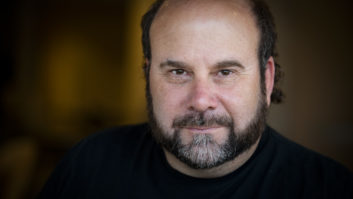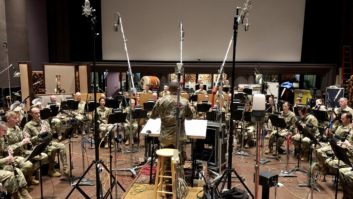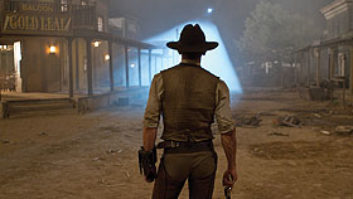Barbershop harmony, a uniquely American musical art form, drew some 14,000 attendees to Portland, Ore.,’s Rose Garden Arena over the 4th of July week. The 64th annual gathering of the Barbershop Society met to pick a champion from 44 competing quartets, each selected via regional competitions around the world. After two sessions of quarterfinals, the top 20 quartets advanced to the semifinals, with 10 going on to the finals. There were also competitions for Best College Quartet and Best Barbershop Chorus.
The Society for the Preservation and Encouragement of Barber Shop Quartet Singing in America (SPEBSQSA) has 16 North American districts and affiliate organizations overseas in the UK, Sweden, The Netherlands and Australia. Glen Glancy, who has acted as the sound director for the Society for the past 28 years, originally became involved with the competition to minimize problems that he encountered when mastering the competition’s recordings at United Sound. Glancy is now president of AMT Systems in Santa Clarita, Calif., and is also the sound contractor responsible for installations such as the Dream Center at the old Angeles Temple in downtown L.A. and at Cathedral of Our Lady of Angels.
This year, Glancy handed over his sound director duties to Daryl Bornstein, whose previous projects range from Leonard Bernstein to jazz at Lincoln Center to Broadway performances. Erik Von Ranson, who mixes the Internet broadcast, and who recently served on the Salt Lake City Olympics’ audio crew for the opening and closing ceremonies, assisted Bornstein.
The competition’s sound system was provided by Seattle’s Morgan Sound, which also provided the system for last November’s international convention of the Sweet Adelines, the female version of the SPEBSQSA, also held at the Rose Garden. Morgan Sound ran out of JBL’s VerTec speakers during the first busy week of summer and wound up subcontracting the system from Audio- Tek (ATK), based out of Burbank, Calif. The 48-box VerTec line array was engineered and installed by Andrew Waterman, ATK’s lead engineer. “Andrew was instrumental in configuring and flying a great-sounding rig quickly,” says Bornstein. While Bornstein had used other line arrays, this was his first experience with the VerTec VT 4889 speaker cabinets and the first use of a line array for this event. “We achieved very even coverage and sound quality throughout the venue,” he comments. “We accomplished this with a relatively lightweight and attractive P.A.”
The entire system hung on eight 1-ton motors and was set up in what would be a typical arrangement for an arena rock show: a pair of 14-box vertical main arrays, with two 10-box arrays covering each side. The main array was split into two sections, which allowed for extra HF “spit” to be added to the upper array in order to compensate for high-frequency loss at the arena’s far end. Powered with QSC PowerLight amplifiers (4.0 models on highs and mids, and 9.0s on the lows), the VerTecs were controlled via XTA 226 processors, as were the E-V 1152 frontfill speakers. Minimal foldback was provided via a single pair of floor monitors angled outward to favor the end singers in each quartet.
Morgan Sound’s Ken Landis used eight floor monitors and eight Shure UHF mics needed for the Association of International Champions (AIC) exhibition, which showcases the previous year’s winners following the first round of quartet competition. At FOH, Bornstein chose an InnovaSon Compact Live console for its ability to quickly write scenes and assemble the 32-input exhibition show — which was, of course, rehearsed out of sequence — and also to provide precisely recallable settings for the competitions.
CRITICAL LISTENING, NO MIXING
Although the competition is open to the public, the audience is predominantly made up of SPEBSQSA members, who have keen hearing and are intimately familiar with this musical style. Between performances, a host announcer at the podium passes time while the audience is allowed to leave their seats, but movement during performances is strictly prohibited and enforced by ushers.
A hallmark of barbershop quartet singing is the ability to “make a chord ring” by creating overtones, which is achieved by modifying the tuning within the 4-note chords, and this feature is listened for during each song. “This might be the most critical-listening audience I’ve ever encountered,” Bornstein points out. “Nonetheless, we’ve had unanimous accolades for the sound quality this year.”
After an initial two-song performance by designated “mic testers” at each session, adjustments on the sound equipment were not permitted. Operation of the console during competition is limited to switching between podium and the performance mics, a chore performed flawlessly by Robert “Bub” Phillippe, a veteran of eight years of competitions.
Onstage, each quartet arranges itself in a semicircle, which allows the singers at each end to hear each other better, as well as favoring the co-incident mic arrangement. A 3.5-foot-diameter semicircle of white tape on the carpeted stage helps the quartets line up properly around the mics. A heavy-based Atlas MS25 mic stand is placed off the front of the stage, with a long boom arm and stereo bar that positions a pair of mics at 42 inches above the deck (mid-chest height), an arrangement that isolates the mics from occasional footwork.
STEREO/MONO COMPATIBILITY
The recommended X-Y approach aligns the capsules of two matched-cardioid condensers with their axes separated by about 110∞. The coincident approach guarantees mono compatibility, while still allowing a stereo recording. (It’s a surprising fact that smaller ensembles actually require a slightly larger angle of separation than do larger groups.) Glancy has authored a technical paper on the Society’s Website that describes the preferred method for quartet reinforcement using a matched pair of mics, along with a list of preferred “pencil” condensers, which include Schoeps MK 4, Neumann KM184, Shure SM81 and several AKG models, such as the C480 and C451.
In previous years, Glancy used a pair of Sennheiser MKH 40s, which he favors for their neutral sound. This year, however, all quartets were miked with Schoeps’ relatively new CMXY 4V stereo mic, essentially a pair of Schoeps’ side-address cardioid CCM 4Vs mounted side-by-side with interlocking gears so that they rotate in opposite directions to adjust the stereo spread. Bornstein points out that the coincident array can be replicated more consistently with a dedicated stereo mic than with a pair of cardioid microphones, an important consideration under contest conditions. “I also feel that the Schoeps sounds better for this specific use, has better reach acoustically, requires less hardware and presents a lower profile on camera than other solutions considered,” he adds. “It’s simple, elegant and accurate.” An MS mic array, which would allow the Society to move up from stereo CDs and VHS recordings to 5.1 recording for DVD release, is also under consideration. However, it remains to be seen if an MS pair has sufficient rear rejection to allow for adequate stage-monitoring levels.
The competition is highly structured: Each group sings two songs and is scored by 15 judges, each specializing in one of three distinct categories: singing, presentation and music. The judges sit in the first three rows and listen to the performance acoustically, thanks to the VerTec line array’s ability to cover the arena with a sharp, defined edge of coverage, even at low frequencies. In the transition area between direct and reinforced sound, behind the judges in the fourth row, a coherent, natural sound is achieved by delaying the VerTec line arrays back to the acoustic sound of the quartets.
The single-session chorus competition, which takes place on the afternoon before the quartet finals, was miked with a Pearl TL 44 stereo mic suspended upstage above and in front of the choral risers, with a Schoeps CCM 4 suspended eight feet to either side. The podium mics, used only for announcements, were redundant Schoeps CCM 5s in cardioid pattern on goosenecks.
After four days of some of the sweetest harmonizing heard, the winners were chosen: Four Voices, from Tennessee (the college champs in 1996), narrowly beat out Ohio’s Uptown Sound. The next three quartets — Power Play from Michigan, Georgia’s Riptide and Metropolis from Santa Fe Springs, Calif. — were separated by only 22 points out of a possible 10,000. The chorus competition was won for a fifth time by The Masters of Harmony, also from Santa Fe Springs, and the college quartet contest was won by Bowling Green, Wisc.,’s Catfish Bend. Next month, the Sweet Adelines meet at the Gaylord Center in Nashville.
Mark Frink is Mix‘s sound reinforcement editor.




